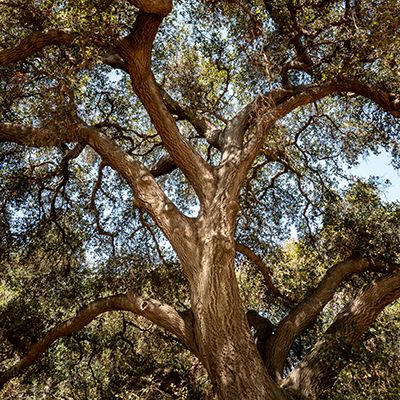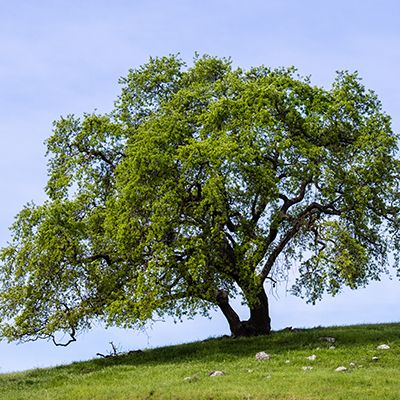

California Native Oaks
There are at least 9 native oaks growing in California: Coast live oak (Quercus agrifolia), blue oak (Q. douglasii), California black oak (Q. kelloggii), and valley oak (Q. lobata) to name a few.
Of these, only two are commonly planted as landscape trees; the coast live oak and the valley oak. The huge oak trees seen next to streets or left as remnants on some of the earlier developed properties are all Valley Oaks and may be 300 or more years old.
If you inherit or plant a native oak as part of your landscaping, special care is required to ensure its survival. Unquestionably, the best way to grow a healthy native oak is from seeds collected from trees in the area and planted in the ground. Be sure to cover and protect them from rodents, especially squirrels.
Oaks need full sun for best growth. If trees are to be planted in the dense clay soil of the Bay area, be sure to amend the soil as described in the Care Guide for Planting Trees & Shrubs.
The area to be amended should be at least three times the diameter of the container but a bit less deep than the soil in the container (“plant high”). A shovel full of soil taken from beneath a healthy oak tree should be mixed with the amendment to provide beneficial fungi. As a general rule, the smallest container plant will be the fasted to root and establish itself in its new environment. After planting, water the seedling thoroughly. A good test is to irrigate until the water in the amended hole has stopped bubbling.
Be sure that water penetrates the root ball of the seedling. To be sure, it may be necessary to make holes in the root ball with a table knife or similar object. Irrigate the plant weekly in this fashion for the first year or two. The seedling should grow two to four feet per year. Do not use any fertilizer for the first year and then lightly with Master Nursery® Formula 49™ about Memorial Day and Labor Day.
When the tree is firmly established, reduce the irrigation to once every two weeks. You will have to adjust your water distribution. A good way is to build a berm just beyond the drip line of the tree and fill the basin with water as described above. Also fertilize lightly with Master Nursery® Formula 49™ as described above. Scatter the fertilizer between the berm and to within six inches of the tree’s trunk.
When your native oak tree has been in the ground for three or four years or is one you have inherited with the property, reduce irrigation to once every three or four weeks. These native oaks should never receive any summer water which wets the area between the drip line and the tree trunk. If there is turf or any other plants in this area, remove them. Mulch this entire area with two to three inches of an organic material such as one inch fir bark. When native oaks grow naturally, they receive no summer water. Under normal conditions, winters are too cold for fungi to grow and summers are too dry. When the well-meaning gardener irrigates a native oak during the summer with a sprinkler that wets the soil for only two to three inches deep, he/she stimulates the activity of water molds.
In this unfamiliar, warm, moist environment, the fungus proliferates and destroys the tree’s roots between the trunk and the tree’s drip line. The tree slowly dies or in a heavy storm blows over because it lacks the support a good root system would have provided. During a drought period, if irrigation is necessary, a soaker hose at the drip line or the berm method of irrigation which permits water to penetrate 18 to 24 inches is permissible but the soil must dry out between irrigations.
During the winter with a normal rain cycle of 18 to 22 inches, enough water is held by the heavy clay soil so that the native oaks do not require supplemental water.
Mediterranean native oaks can take a year round irrigation or go without summer water. A good example of such an oak is the holly oak (Q. ilex); this tree is evergreen, closely resembles the coast live oak and seems to have fewer pests.
Eastern oaks such as the pin oak or northern red oak provide good fall color in the east and Midwest. Unfortunately, they grow best in deep acidic soils. In the Peninsula area, they will suffer in our dense, alkaline, clay soil.
California native oaks are troubled by a few easily controlled pests. Most of the fungi (crown rot, oak root fungus, etc.) are controlled by keeping the soil dry in the summer. Chewing insects (caterpillars and beetles) can be eliminated by spraying non-toxic (organic) insecticides such as Monterey B.t. or Spinosad. Similarly, white flies, scale and aphids can be controlled with non-toxic Master Nursery® Pest Fighter Year- Round Spray Oil.
By following these directions, California native and Mediterranean oaks can be established in and will be among the most carefree of trees in the landscape.